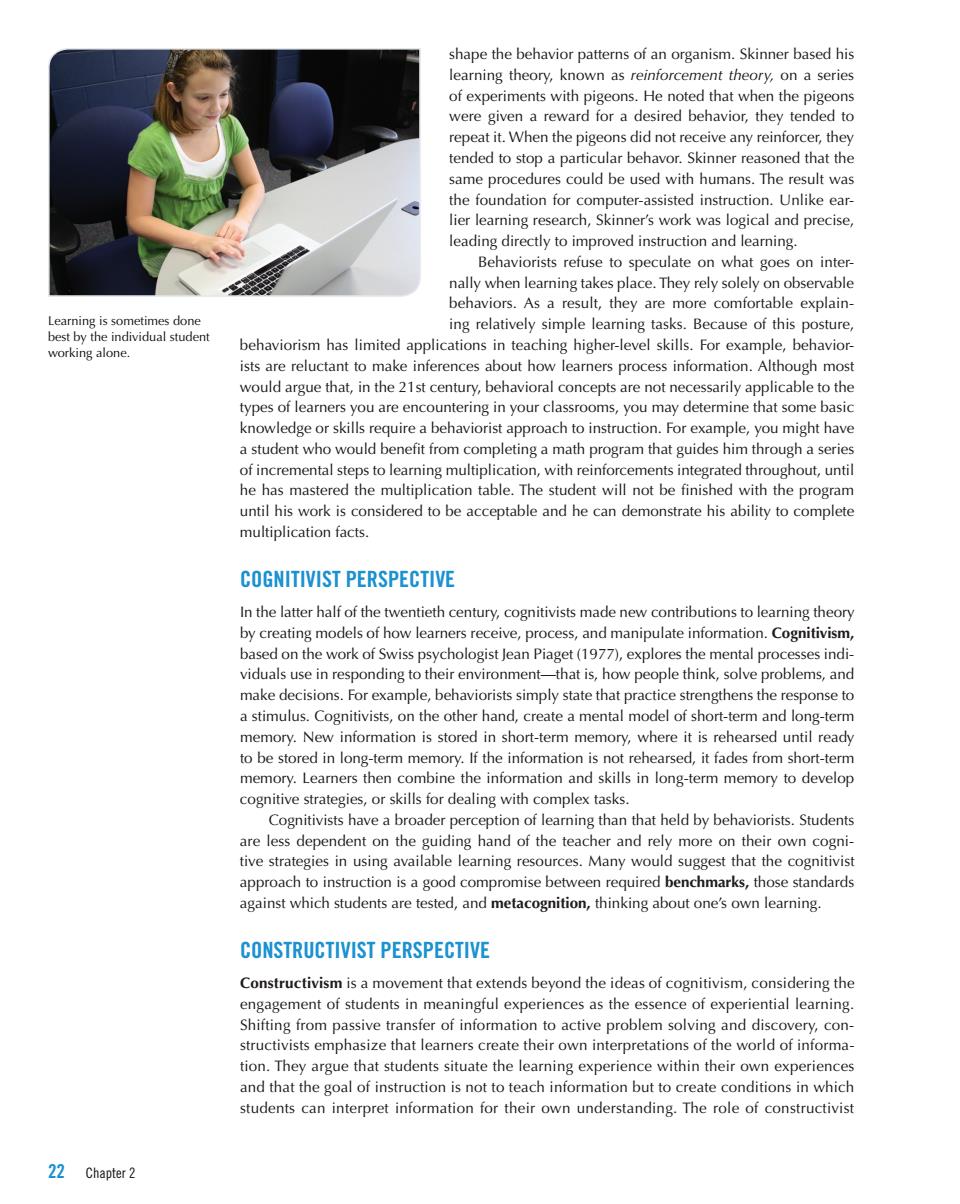正在加载图片...

hape the behavior patters of an organism.Skinner based his rning theory, n as rel nforcement theory,on a serie t experiments wit the were given a re sired bet cet,the tended to stop a particular behavor.Skinner reasoned that the ame procedures could be used with humans.The result was the foundation for computer-assisted instruction.Unlike ear er learning research,Skinner's work was logical and precise eading directly to improved instruction and learning. Behaviorists refuse to speculate on what goes on inter nally when learning takes place.They rely solely on observable behaviors.As a result,they are more comfortable explain- ing relatively simple learning tasks.Because of this posture working alone behaviorism has limited applications in teaching higher-level skills.For example,behavior- ists are reluctant to make inferences about how learners process information.Although most would argue that,in the 21st century,behavioral concepts are not necessarily applicable to the types of learners you are encountering in your classrooms,you may determine that some basic knowledge or skills require a behaviorist approach to instruction.For example,you might have a student who would benefit from completing a math prooram that guides him through a series of incremental steps to learning multiplication,with reinforcements integrated throughout.until he has mastered the multiplication table.The student will not be finished with the program until his work is considered to be acceptable and he can demonstrate his ability to complete multiplication facts. COGNITIVIST PERSPECTIVE In the latter half of the twentieth century,cognitivists made new contributions to learning theory by creating models of how learners receive,process,and manipulate information.Cognitivism based on the work of Swiss psychologist Jean Piaget(1977),explores the mental proce esses indi. viduals use in responding to their environment-that is,how people think,solve problems,and make decisions.For example,behaviorists simply state that practice strengthens the response to a stimulus.Cognitivists,on the other hand,create a mental model of short-term and long-term mory,where it is rehearsed until ready ored in long-tern the is not rehearsed,it fades from shor-ter isngcm mod tonoreplertasks ing than that held by behavic ists.Studente hand of the tea and l in using available le ning re M y would t that th tudents are tes ed,an eta ing ab earning CONSTRUCTIVIST PERSPECTIVE Constructivism isa movement that extends beyond the ideas of cognitivism,considering the ont of stude of h structivists asize that le n in world of inf tion.They that s ate the lea nd th al of in students can interpret information for their own understanding.The role of constructivis 22 Chapter 222 Chapter 2 shape the behavior patterns of an organism. Skinner based his learning theory, known as reinforcement theory, on a series of experiments with pigeons. He noted that when the pigeons were given a reward for a desired behavior, they tended to repeat it. When the pigeons did not receive any reinforcer, they tended to stop a particular behavor. Skinner reasoned that the same procedures could be used with humans. The result was the foundation for computer- assisted instruction. Unlike earlier learning research, Skinner’s work was logical and precise, leading directly to improved instruction and learning. Behaviorists refuse to speculate on what goes on internally when learning takes place. They rely solely on observable behaviors. As a result, they are more comfortable explaining relatively simple learning tasks. Because of this posture, behaviorism has limited applications in teaching higher- level skills. For example, behaviorists are reluctant to make inferences about how learners process information. Although most would argue that, in the 21st century, behavioral concepts are not necessarily applicable to the types of learners you are encountering in your classrooms, you may determine that some basic knowledge or skills require a behaviorist approach to instruction. For example, you might have a student who would benefit from completing a math program that guides him through a series of incremental steps to learning multiplication, with reinforcements integrated throughout, until he has mastered the multiplication table. The student will not be finished with the program until his work is considered to be acceptable and he can demonstrate his ability to complete multiplication facts. Cognitivist Perspective In the latter half of the twentieth century, cognitivists made new contributions to learning theory by creating models of how learners receive, process, and manipulate information. Cognitivism, based on the work of Swiss psychologist Jean Piaget (1977), explores the mental processes individuals use in responding to their environment—that is, how people think, solve problems, and make decisions. For example, behaviorists simply state that practice strengthens the response to a stimulus. Cognitivists, on the other hand, create a mental model of short-term and long-term memory. New information is stored in short- term memory, where it is rehearsed until ready to be stored in long-term memory. If the information is not rehearsed, it fades from short-term memory. Learners then combine the information and skills in long- term memory to develop cognitive strategies, or skills for dealing with complex tasks. Cognitivists have a broader perception of learning than that held by behaviorists. Students are less dependent on the guiding hand of the teacher and rely more on their own cognitive strategies in using available learning resources. Many would suggest that the cognitivist approach to instruction is a good compromise between required benchmarks, those standards against which students are tested, and metacognition, thinking about one’s own learning. Constructivist Perspective Constructivism is a movement that extends beyond the ideas of cognitivism, considering the engagement of students in meaningful experiences as the essence of experiential learning. Shifting from passive transfer of information to active problem solving and discovery, constructivists emphasize that learners create their own interpretations of the world of information. They argue that students situate the learning experience within their own experiences and that the goal of instruction is not to teach information but to create conditions in which students can interpret information for their own understanding. The role of constructivist Learning is sometimes done best by the individual student working alone. M02_SMAL4150_01_SE_C02.indd 22 2/7/14 8:37 AM